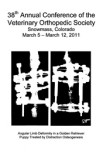OBJECTIVES:
To (1) develop a technique to determine the anteversion angle (AA) of the femur on a single radiograph; (2) determine the correlation between this technique and other published radiographic and computed tomographic (CT) methods; and (3) compare the diagnostic outcome of these methods in determining the level at which femoral torsion occurred in Labrador Retrievers with cranial cruciate ligament (CCL) deficiency.
STUDY DESIGN:
Cross-sectional clinical study.
ANIMALS:
Mature pure-bred Labrador Retrievers (n = 30).
METHODS:
Pelvic limbs (n = 28) of 14 dogs without CCL deficiency were classified as control, whereas limbs of 16 dogs (18 limbs) with CCL deficiency were considered as diseased. Femoral torsion was evaluated using radiography and CT and variables were compared among limb groups by use of a mixed-model ANOVA, with P < .05 considered significant.
RESULTS:
There was a significant association between biplanar and lateral plane AAs but neither correlated with CT assessment of femoral torsion. On CT, a significant correlation was identified between overall AA and each of the distal, proximal, and femoral head trochanteric angles. Biplanar and lateral plane AAs did not differ between normal and CCL deficient limbs. On CT, overall and distal AAs were increased in CCL deficient limbs compared to control.
CONCLUSION:
Biplanar determination of femoral torsion can be estimated based on a single lateral radiograph but the results will be inaccurate as only CT identified and localized the site of femoral torsion.









